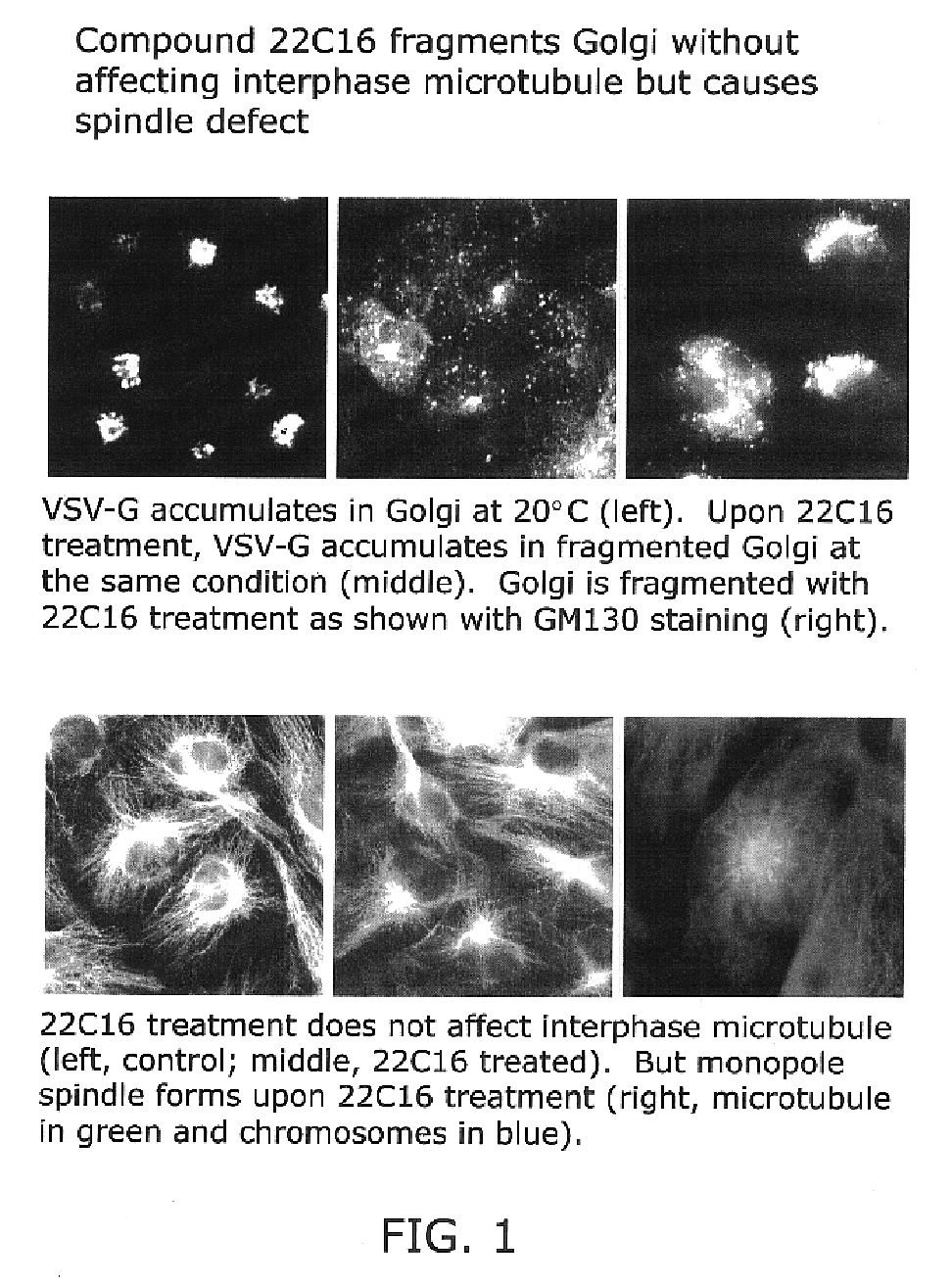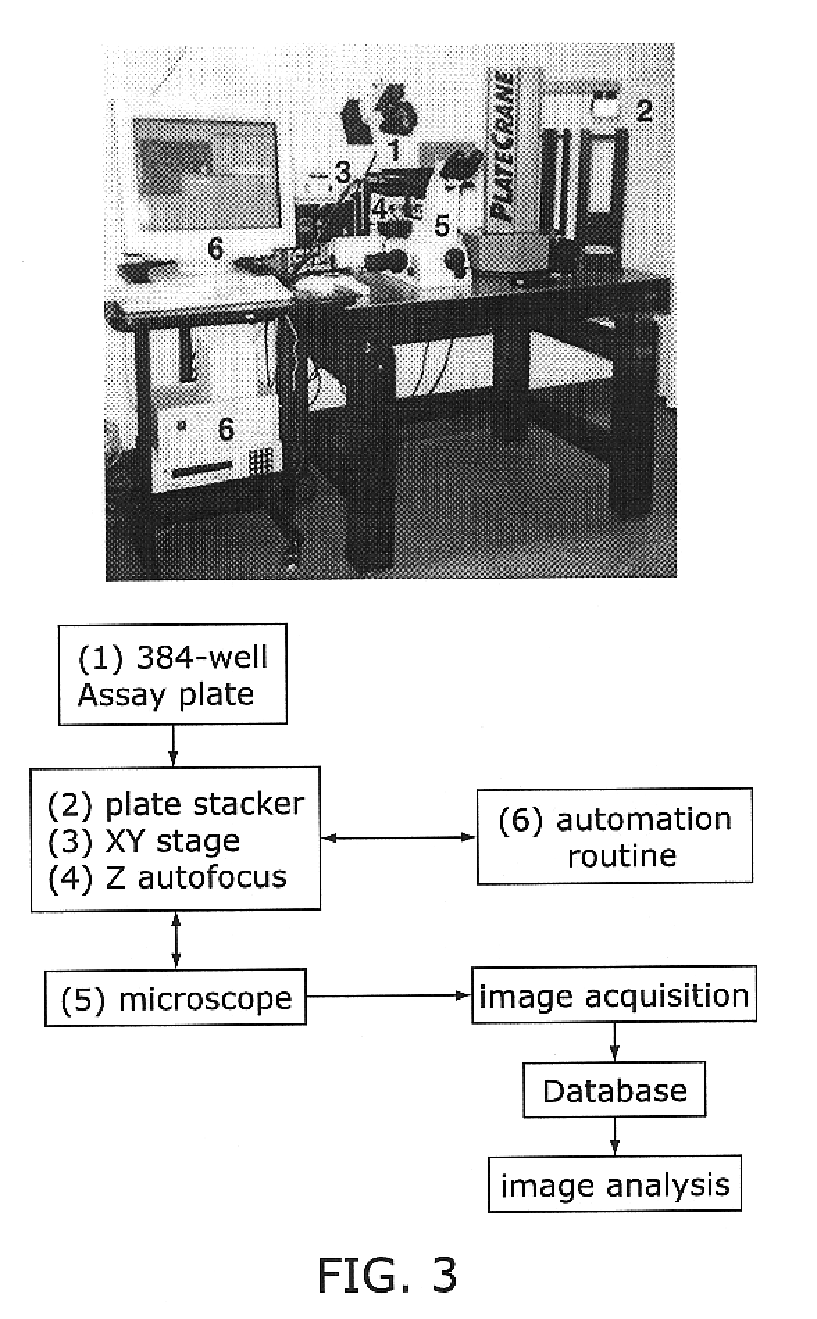Kinesin inhibitors
a technology of kinesin and inhibitors, applied in the field of kinesin inhibitors, can solve the problems of difficult establishment of specific cargo inability to provide modulators for most of the proteins, and inability to meet the needs of a given motor protein, so as to inhibit the activity of a protein and inhibit mitosis
- Summary
- Abstract
- Description
- Claims
- Application Information
AI Technical Summary
Benefits of technology
Problems solved by technology
Method used
Image
Examples
example 1
Screen to Identify Small Molecule Inhibitors of Exocytosis Automated Image Capture
[0093]Automated screening microscope was developed to allow medium-throughput imaging-based screening. A Nikon inverted fluorescence microscope equipped with a 20× dry lens (F 0.45) was equipped with a cooled charged coupled device (CCD) camera and the Metamorph software suite (Universal Imaging Corp.) for data acquisition. Changes in the focal plane were obtained by controlling the focal length of the optical path with a piezo-electric collar attached to the 20× dry lens with steps of 5 μm on a total range of 300 μm. Best focus was achieved by using an algorithm that searches for maximum contrast on the acquired image. The microscope set-up is diagrammed in FIG. 3.
The Metamorph Software Performs the Following Tasks:
[0094](1) automatically center the lens in each well of a tissue culture plate (in our case, 384-well plates);[0095](2) automatically focus the image, by collecting 25 images in different f...
example 2
ATPase Assay with Purified Human Eg5 Kinesin
[0105]Monastrol and 22C16 were both determined to block the ATPase activity of human Eg5 (N-terminal 405 amino acids and 6-His tagged at C terminus). Monastrol did not inhibit the activity of human kinesin (N-terminal 560 amino acids of full length protein followed by 6-His tag at C terminus).
Methods
Preparation of Recombinant Human Eg5 Kinesin (Eg5-405)
[0106]DNA encoding full length human Eg5 kinesin was amplified by the polymerase chain reaction (PCR) using Vent DNA polymerase (NE Biolabs, Beverly, Mass.) and subcloned into an expression plasmid (pRSETa). For the PCR reaction, the template used was a pBluescript vector containing the full length coding sequence for human Eg5 (a gift from Anne Blangy). The 5′ primer (5′-GCA ACG ATT AAT ATG GCG TCG CAG CCA AAT TCG TCT GCG AAG) contained an Ase I cleavage site upstream of the Eg5 start codon. The 3′ primer (5′-GCA ACG CTC GAG TCA GTG ATG ATG GTG GTG ATG CAT GAC TCT AAA ATT TTC TTC AGA AAT) w...
example 3
Synthesis of Monastroline
[0116]The synthesis of monastroline (22C16) was performed via the Pictet-Spengler reaction (Ber. 44:2030, 1911; Whaley and Govindachari. Org. Reaction. 6:74, 1951; Ungemach et al. J. Amer. Chem. Soc. 102:6976-6984, 1980). Recent examples of the use of the Pictet-Spengler reaction are provided by Rousseau and Dodd (J. Org. Chem. 63:2731-2737, 1998) and by Leonard et al. (Tet. Lett. 38:3071-3074, 1997).
[0117]FIG. 10 depicts the synthetic reaction scheme for monastroline using the Pictet-Spengler reaction. D,L-tryptophan (Sigma-Aldrich) was used as the starting material. D,L-tryptophan was refluxed with 3-hydroxylbenzaldehyde (Sigma-Aldrich) in methanol for approximately 6 hours. The racemic beta-carboline was purified and refluxed with n-Bu-ICN in acetone for approximately 48 hours. Cis and trans isomers of monastroline were separated and purified by standard silica gel chromatography.
PUM
| Property | Measurement | Unit |
|---|---|---|
| focal length | aaaaa | aaaaa |
| focal length | aaaaa | aaaaa |
| permissive temperature | aaaaa | aaaaa |
Abstract
Description
Claims
Application Information
 Login to View More
Login to View More - R&D
- Intellectual Property
- Life Sciences
- Materials
- Tech Scout
- Unparalleled Data Quality
- Higher Quality Content
- 60% Fewer Hallucinations
Browse by: Latest US Patents, China's latest patents, Technical Efficacy Thesaurus, Application Domain, Technology Topic, Popular Technical Reports.
© 2025 PatSnap. All rights reserved.Legal|Privacy policy|Modern Slavery Act Transparency Statement|Sitemap|About US| Contact US: help@patsnap.com



